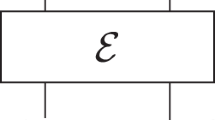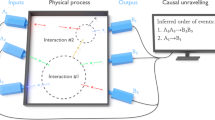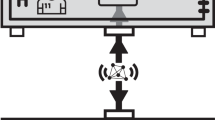Abstract
The problem of inferring causal relations from observed correlations is relevant to a wide variety of scientific disciplines. Yet given the correlations between just two classical variables, it is impossible to determine whether they arose from a causal influence of one on the other or a common cause influencing both. Only a randomized trial can settle the issue. Here we consider the problem of causal inference for quantum variables. We show that the analogue of a randomized trial, causal tomography, yields a complete solution. We also show that, in contrast to the classical case, one can sometimes infer the causal structure from observations alone. We implement a quantum-optical experiment wherein we control the causal relation between two optical modes, and two measurement schemes—with and without randomization—that extract this relation from the observed correlations. Our results show that entanglement and quantum coherence provide an advantage for causal inference.
This is a preview of subscription content, access via your institution
Access options
Subscribe to this journal
Receive 12 print issues and online access
$209.00 per year
only $17.42 per issue
Buy this article
- Purchase on Springer Link
- Instant access to full article PDF
Prices may be subject to local taxes which are calculated during checkout




Similar content being viewed by others
References
Reichenbach, H. The Direction of Time (Univ. of California Press, 1956).
Pearl, J. Causality: Models, Reasoning and Inference (Cambridge Univ. Press, 2000).
Spirtes, P., Glymour, C. & Scheines, R. Causation, Prediction, and Search (MIT Press, 2000).
Mooij, J. M., Peters, J., Janzing, D., Zscheischler, J. & Schölkopf, B. Distinguishing cause from effect using observational data: Methods and benchmarks. Preprint at http://arxiv.org/abs/1412.3773 (2014).
Fitzsimons, J., Jones, J. & Vedral, V. Quantum correlations which imply causation. Preprint at http://arxiv.org/abs/1302.2731 (2013).
Richardson, T. S. & Robins, J. M. Single World Intervention Graphs (SWIGs): A Unification of the Counterfactual and Graphical Approaches to Causality (CSSS, University of Washington, 2013).
Chiribella, G., D’Ariano, G. M. & Perinotti, P. Theoretical framework for quantum networks. Phys. Rev. A 80, 022339 (2009).
Hardy, L. The operator tensor formulation of quantum theory. Phil. Trans. R. Soc. A 370, 3385–3417 (2012).
Oreshkov, O., Costa, F. & Brukner, C. Quantum correlations with no causal order. Nature Commun. 3, 1092 (2012).
Leifer, M. & Spekkens, R. W. Towards a formulation of quantum theory as a causally neutral theory of Bayesian inference. Phys. Rev. A 88, 052130 (2013).
Leifer, M. S. Quantum dynamics as an analog of conditional probability. Phys. Rev. A 74, 042310 (2006).
Aharonov, Y., Popescu, S., Tollaksen, J. & Vaidman, L. Multiple-time states and multiple-time measurements in quantum mechanics. Phys. Rev. A 79, 052110 (2009).
Oeckl, R. A “general boundary” formulation for quantum mechanics and quantum gravity. Phys. Lett. B 575, 318–324 (2003).
Choi, M. D. Completely positive linear maps on complex matrices. Linear Algebr. Appl. 10, 285–290 (1975).
D’Ariano, G. M. & Lo Presti, P. Quantum tomography for measuring experimentally the matrix elements of an arbitrary quantum operation. Phys. Rev. Lett. 86, 4195–4198 (2001).
Jozsa, R. Fidelity for mixed quantum states. J. Mod. Opt. 41, 2315–2323 (1994).
Wolf, M. M., Eisert, J., Cubitt, T. & Cirac, J. Assessing non-Markovian quantum dynamics. Phys. Rev. Lett. 101, 150402 (2008).
Laine, E-M., Piilo, J. & Breuer, H-P. Measure for the non-Markovianity of quantum processes. Phys. Rev. A 81, 062115 (2010).
Rivas, Á., Huelga, S. F. & Plenio, M. B. Quantum non-Markovianity: Characterization, quantification and detection. Rep. Prog. Phys. 77, 094001 (2014).
Rivas, Á., Huelga, S. F. & Plenio, M. B. Entanglement and non-Markovianity of quantum evolutions. Phys. Rev. Lett. 105, 050403 (2010).
Lu, X-M., Wang, X. & Sun, C. Quantum Fisher information flow and non-Markovian processes of open systems. Phys. Rev. A 82, 042103 (2010).
Liu, B-H. et al. Experimental control of the transition from Markovian to non-Markovian dynamics of open quantum systems. Nature Phys. 7, 931–934 (2011).
Tang, J-S. et al. Measuring non-Markovianity of processes with controllable system-environment interaction. Europhys. Lett. 97, 10002 (2012).
Wallman, J., Flammia, S., Barnhill, M. & Emerson, J. Simpler, faster, better: Robust randomized benchmarking tests for non-unitality and non-Markovianity in quantum devices. Bull. Am. Phys. Soc. 77 (2014).
Pechukas, P. Reduced dynamics need not be completely positive. Phys. Rev. Lett. 73, 1060–1062 (1994).
Altepeter, J. B. et al. Ancilla-assisted quantum process tomography. Phys. Rev. Lett. 90, 193601 (2003).
Boulant, N., Emerson, J., Havel, T. F., Cory, D. G. & Furuta, S. Incoherent noise and quantum information processing. J. Chem. Phys. 121, 2955–2961 (2004).
Weinstein, Y. S. et al. Quantum process tomography of the quantum Fourier transform. J. Chem. Phys. 121, 6117–6133 (2004).
Howard, M. et al. Quantum process tomography and Lindblad estimation of a solid-state qubit. New J. Phys. 8, 33 (2006).
Carteret, H., Terno, D. R. & Zyczkowski, K. Physical accessibility of non-completely positive maps. Phys. Rev. A 77, 042113 (2008).
Kim, T., Fiorentino, M. & Wong, F. N. C. Phase-stable source of polarization-entangled photons using a polarization Sagnac interferometer. Phys. Rev. A 73, 012316 (2006).
Fedrizzi, A., Herbst, T., Poppe, A., Jennewein, T. & Zeilinger, A. A wavelength-tunable fiber-coupled source of narrowband entangled photons. Opt. Express 15, 15377–15386 (2007).
Biggerstaff, D. N. et al. Cluster-state quantum computing enhanced by high-Fidelity generalized measurements. Phys. Rev. Lett. 103, 240504 (2009).
Kwiat, P. G., Mitchell, J. R., Schwindt, P. D. D. & White, A. G. Grover’s search algorithm: An optical approach. J. Mod. Opt. 47, 257–266 (2000).
Nagata, T., Okamoto, R., O’Brien, J. L., Sasaki, K. & Takeuchi, S. Beating the standard quantum limit with four-entangled photons. Science 316, 726–729 (2007).
Acknowledgements
We thank J. M. Donohue and J. Lavoie for valuable discussions, and M. Mazurek for his assistance in preparing the figures. This research was supported in part by the Natural Sciences and Engineering Research Council of Canada (NSERC), Canada Research Chairs, Industry Canada and the Canada Foundation for Innovation (CFI). Research at Perimeter Institute is supported by the Government of Canada through Industry Canada and by the Province of Ontario through the Ministry of Research and Innovation.
Author information
Authors and Affiliations
Contributions
D.J. and R.W.S. conceived the original idea for the project. K.R. and R.W.S. developed the project and the theory. M.A. and K.J.R. designed the experiment. M.A. and L.V. performed the experiment. M.A., K.R. and K.J.R. performed the numerical calculations. M.A., K.R., K.J.R. and R.W.S. analysed the results. K.R., M.A. and R.W.S. wrote the first draft of the paper and all authors contributed to the final version.
Corresponding author
Ethics declarations
Competing interests
The authors declare no competing financial interests.
Supplementary information
Supplementary Information
Supplementary Information (PDF 1018 kb)
Rights and permissions
About this article
Cite this article
Ried, K., Agnew, M., Vermeyden, L. et al. A quantum advantage for inferring causal structure. Nature Phys 11, 414–420 (2015). https://doi.org/10.1038/nphys3266
Received:
Accepted:
Published:
Issue Date:
DOI: https://doi.org/10.1038/nphys3266
This article is cited by
-
Quantum causal unravelling
npj Quantum Information (2022)
-
Entanglement, Complexity, and Causal Asymmetry in Quantum Theories
Foundations of Physics (2022)
-
Quantum causal models: the merits of the spirit of Reichenbach’s principle for understanding quantum causal structure
Synthese (2022)
-
Cyclic quantum causal models
Nature Communications (2021)
-
Quantum speedup in the identification of cause–effect relations
Nature Communications (2019)



